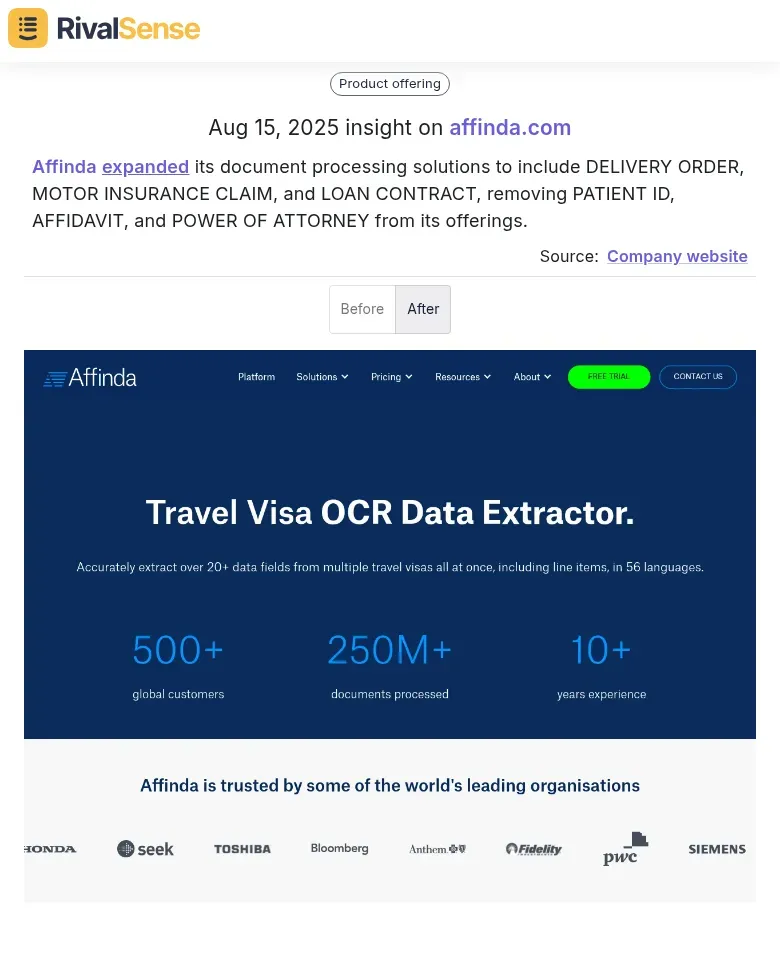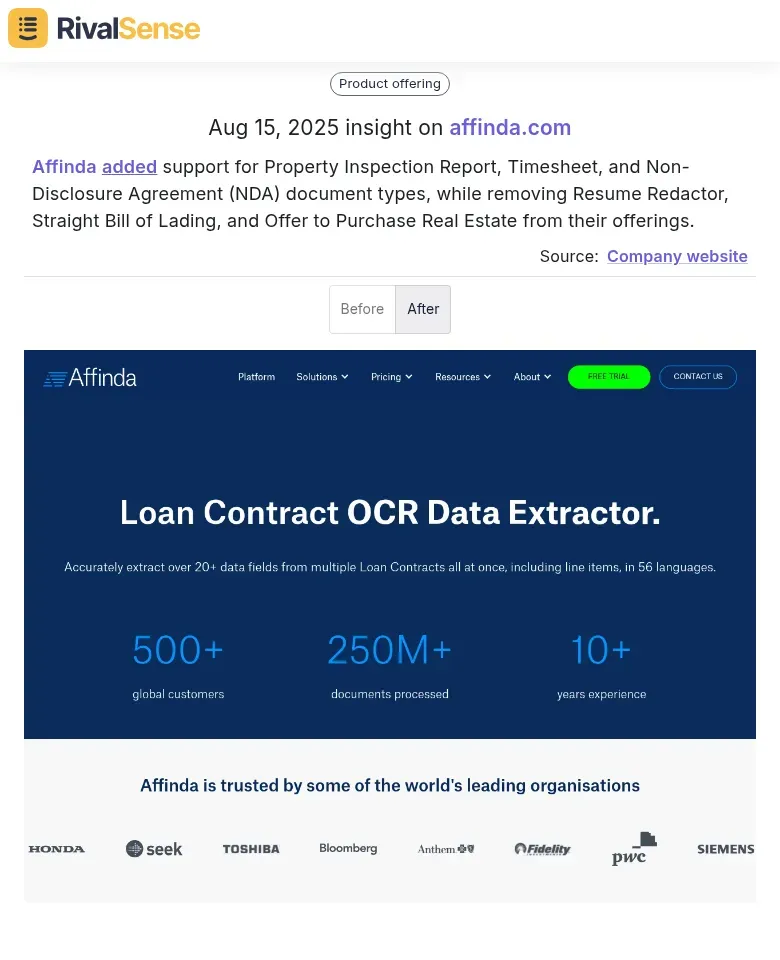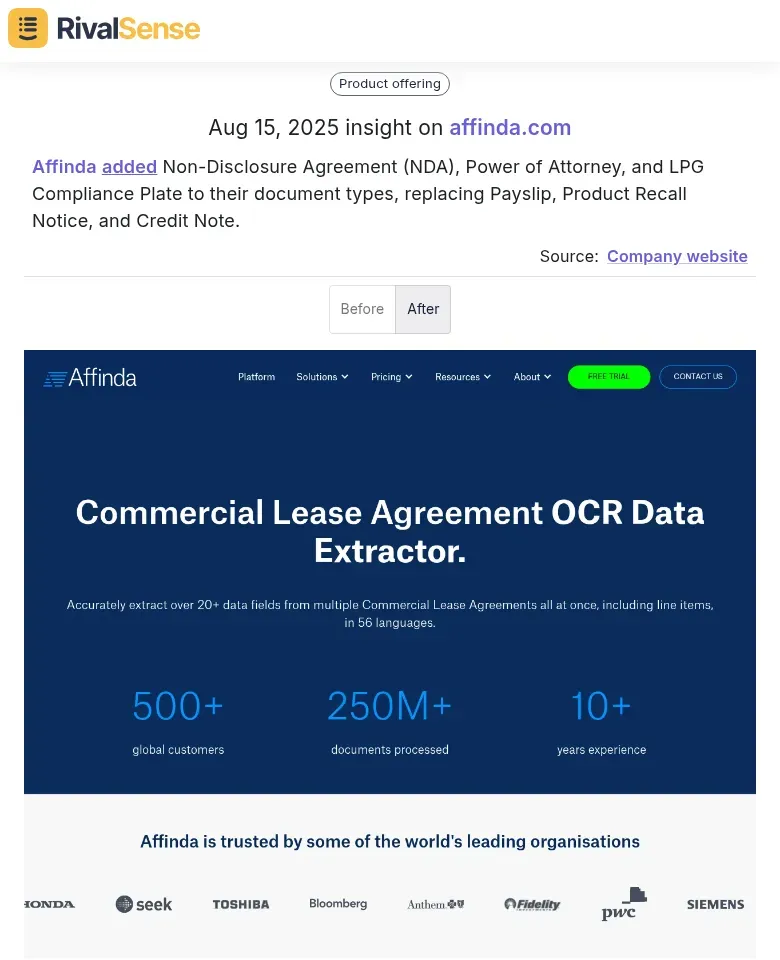Boost Corporate Wellness with Competitive Research Methods
Corporate wellness programs significantly enhance employee health, directly boosting productivity, morale, and organizational performance. These initiatives reduce absenteeism, lower healthcare costs, and strengthen engagement. However, maximizing their impact requires leveraging competitive research to benchmark against industry leaders and identify emerging trends.
Competitive research refines wellness programs by revealing gaps and best practices. For instance, analyzing how rivals integrate mental health support or fitness incentives provides actionable insights. Beyond wellness, tracking competitor product shifts is equally valuable—like RivalSense detecting Affinda’s document processing expansion into DELIVERY ORDER and LOAN CONTRACT while phasing out PATIENT ID. 
Why this matters: Such insights expose strategic pivots—here, Affinda prioritizing logistics/finance sectors—helping you anticipate market shifts and align offerings accordingly.
Applying competitive research involves:
- Identify Competitors: Target companies with acclaimed wellness programs.
- Gather Data: Use surveys, public reports, or digital tools.
- Analyze Trends: Spot patterns like flexible work or wellness apps.
- Benchmark: Compare your program’s features against peers.
- Implement Changes: Adapt successful strategies to your context.
Integrating these steps creates wellness programs that exceed expectations, driving long-term success.
Identifying Key Competitors in the Corporate Wellness Space
Pinpointing competitors is foundational for impactful competitive research. Start by categorizing rivals to understand their influence on your strategy. This clarity helps prioritize resources and uncover differentiation opportunities.
1. Identifying Direct and Indirect Competitors
- Direct Competitors: Businesses with similar wellness offerings (e.g., Wellable or Burnalong for on-site fitness).
- Indirect Competitors: Solutions addressing overlapping needs (e.g., Headspace for mental wellness if you offer stress management).
Practical Tip: Use Google or industry reports (e.g., Grand View Research) with keywords like "top corporate wellness companies." Monitor product changes too—like Affinda adding Property Inspection Reports while removing Offer to Purchase Real Estate. 
Why this matters: Tracking additions/removals reveals focus shifts—here, Affinda streamlining toward core business documents—guiding your own resource allocation.
2. Tools and Techniques for Gathering Competitor Data
- Competitor Websites: Scour offerings, pricing, and testimonials.
- Social Media: Track engagement on LinkedIn or Twitter.
- Customer Reviews: Check G2 or Capterra for unbiased feedback.
- Industry Reports: Utilize IBISWorld or Fortune Business Insights.
Checklist for Competitor Research:
- [ ] Document competitor USPs from their websites
- [ ] Follow rivals on social media
- [ ] Analyze third-platform reviews
- [ ] Subscribe to industry newsletters
3. Analyzing Competitor Strengths and Weaknesses
- Strengths: Note excellence areas (e.g., Virgin Pulse’s HR integration).
- Weaknesses: Identify gaps like poor mental health support.
Actionable Steps:
- Conduct SWOT analyses for key rivals.
- Compare pricing, features, and satisfaction metrics.
- Address unmet needs in your program.
Systematic competitor analysis sharpens your wellness strategy.
Leveraging Competitive Insights for Wellness Program Design
Competitive research transforms raw data into innovative wellness strategies. Analyze rival programs to spot underserved areas—like financial wellness—and capitalize on them for differentiation. This proactive approach turns intelligence into tangible advantages.
For example, Affinda’s addition of Non-Disclosure Agreements and LPG Compliance Plates (replacing Payslips) signaled a compliance focus. 
Why this matters: Detecting such shifts helps anticipate service gaps—similar to identifying missing mental health resources in competitor wellness programs.
Steps to Translate Data into Strategies:
- Benchmark Programs: Track initiatives using competitive tools.
- Identify Gaps: Find overlooked areas (e.g., financial wellness).
- Customize Offerings: Introduce flexible scheduling or AI-driven plans.
- Measure Impact: Set KPIs against competitor benchmarks.
Case Study: A tech firm replaced generic fitness challenges with personalized AI plans, boosting engagement by 30%.
Pro Tip: Update research quarterly—wellness trends evolve rapidly.
Measuring the Effectiveness of Your Wellness Initiatives
Quantifying program success ensures ROI and continuous improvement. Track participation rates, biometric data (e.g., BMI), mental health indicators, and cost savings from reduced absenteeism. Without measurement, even well-designed initiatives risk underperformance.
Benchmark rigorously against competitors. Compare your participation rates, benefit diversity, and health outcomes using surveys or industry reports. This reveals competitive standing and highlights improvement areas.
Actionable Steps:
- Set quarterly reviews to analyze KPIs.
- Use competitor insights to refine metrics (e.g., if rivals excel in mental health support, track your related engagement).
- Leverage tech for real-time data tracking.
- Solicit employee feedback to align offerings with needs.
Continuous measurement and adaptation keep programs impactful and competitive.
Future Trends in Corporate Wellness and Competitive Research
Corporate wellness is evolving toward hyper-personalization and holistic health, integrating physical, mental, and financial well-being. Competitive research must parallel this shift, using advanced tools to forecast trends and outmaneuver rivals.
AI and predictive analytics will dominate research. Sentiment analysis of employee feedback on competitor programs, for instance, can uncover unmet needs. Simultaneously, expect wellness programs to blend wearables, genetic testing, and financial coaching.
Practical Steps:
- Monthly Audits: Review competitors’ wellness updates.
- Social Listening: Monitor rival announcements via tools like RivalSense.
- Pilot Innovations: Test AI-driven wellness plans based on competitor gaps.
Staying agile ensures your program leads rather than follows.
Conclusion and Next Steps
Competitive research elevates corporate wellness programs by uncovering benchmarks, gaps, and innovation opportunities. By analyzing rivals, you can design initiatives that boost productivity, retention, and employee satisfaction—turning wellness into a strategic advantage.
Immediate Actions:
- Identify Competitors: Focus on industry/size peers.
- Gather Data: Use tools like RivalSense for real-time tracking.
- Analyze Trends: Spot patterns in wellness offerings.
- Implement Findings: Adapt successful strategies to your culture.
- Monitor Continuously: Update research bi-monthly.
Elevate your strategy: Try RivalSense for free at https://rivalsense.co/—get your first competitor report today. Track product launches, pricing changes, partnerships, and media mentions to stay ahead.
📚 Read more
👉 How Affinda's Document Shift Empowered Competitors to Adapt
👉 Competitive Edge: Unlocking Rival Insights from Twitter and Beyond
👉 Predictive Analysis for TV Ad Competitive Strategy Success 🚀
👉 Leveraging Competitor Insights for Smarter Financial Strategies
👉 How Euro Foods' Product Shifts Reveal Strategic Opportunities
